Perspectives in Aptasensor-Based Portable Detection for Biotoxins
Abstract
:1. Introduction
| Types | Representative | Source | Toxic Effect | Symptoms | Ref. |
|---|---|---|---|---|---|
| Animal toxins | Bungarotoxin (α-BGT and β-BGT) | Bungarus multicinctus | Nervous system, lung and heart | Wound pain, localized swelling, salivation, nausea, vomiting, coma, respiratory failure and death | [17] |
| Cardiotoxins (CTXs) | Naja atra | Nervous system, heart | Damage to the heart, arrhythmias, myocardial hypoxia | [18] | |
| Plant toxins | Abrin | Abrus Precatorirus | Liver, kidneys, spleen, blood cells, lung and heart | Diarrhea, vomiting, colic, tachycardia, kidney failure, respiratory failure and death | [19] |
| Ricin | Ricinus communis | Liver, kidney, cardiovascular and respiratory center | Nausea, vomiting, abdominal pain, diarrhea, convulsions, shock and death | ||
| Microbial toxins | Aflatoxin (B1, B2, G1, G2, M1, M2) | Aspergillus | liver, kidney, gastrointestinal tract | Fever, vomiting, anorexia, jaundice, followed by ascites, swelling of the lower extremities and rapid death | [20] |
| Ochrotoxin A (OTA) | Aspergillus and Penicillium | Kidney, liver, immune system | Mental depression, loss of appetite, weight loss, digestive disorders, kidney damage, and often abortion | [21] | |
| Zearalenone (ZEN) | Fusarium and Gibberella | Reproductive system, nervous system, heart, kidney, liver and lung | Nausea, chills, headache, depression, ataxia, miscarriage, stillbirth and teratology | [22] | |
| Botulinum toxin | Clostridium botulinum | Nervous system | Ptosis, diplopia, strabismus, dysphagia, dizziness, muscle weakness, dyspnea and death | [23] | |
| Staphylococcal enterotoxins | Staphylococcus aureus | Immune system | Nausea, vomiting and diarrhea | [24] | |
| Marine toxins | Saxitoxin (STX) | Alexandrium catenella, Gonyaulax catenella, and Alexandrium tamarense | Nervous system, cardiovascular system | Nausea, vomiting, diarrhea, local skin tingling sensation, neuromuscular paralysis, arrhythmia, death | [25] |
| Okadaic acid (OA) | Dinophysis and Prorocentrum | Intestines tract, liver and nerves | Bellyache, queasiness, chilli-ness, abdominal pain, Cancer | [26] | |
| Ciguatoxins | Gambierdiscus toxicus, Prorocentrum and Pyrocystis | Nervous system and respiratory center | Weakness of the limbs, inability to speak, drooping eyelids, staggering, coma, respiratory failure and death | [27] | |
| Tetrodotoxins | Gambierdiscums toxincus, puffer fish | Nervous system and sodium ion channel inhibitors | Respiratory failure and death | [28] | |
| Palytoxins (PTX) | Palythoa and Zoanthus | Cardiovascular, nervous system, digestive tract and kidney | Blisters, bleeding or ulcers, dyspnea, vomiting, extensive gastrointestinal bleeding, shock, and death | [29] |
2. Aptamers Targeting Biotoxins
2.1. Selection Principle of Aptamers
2.2. Overview of Aptamers Targeting Biotoxins
3. Portable Aptasensors for Biotoxin Determination
3.1. Portable Aptasensors Based on LFAs
3.1.1. Colorimetric LFA Aptasensors
3.1.2. Fluorescent LFA Aptasensors

3.2. Portable Aptasensors Based on PGMs
3.2.1. Enzymatic Reactions
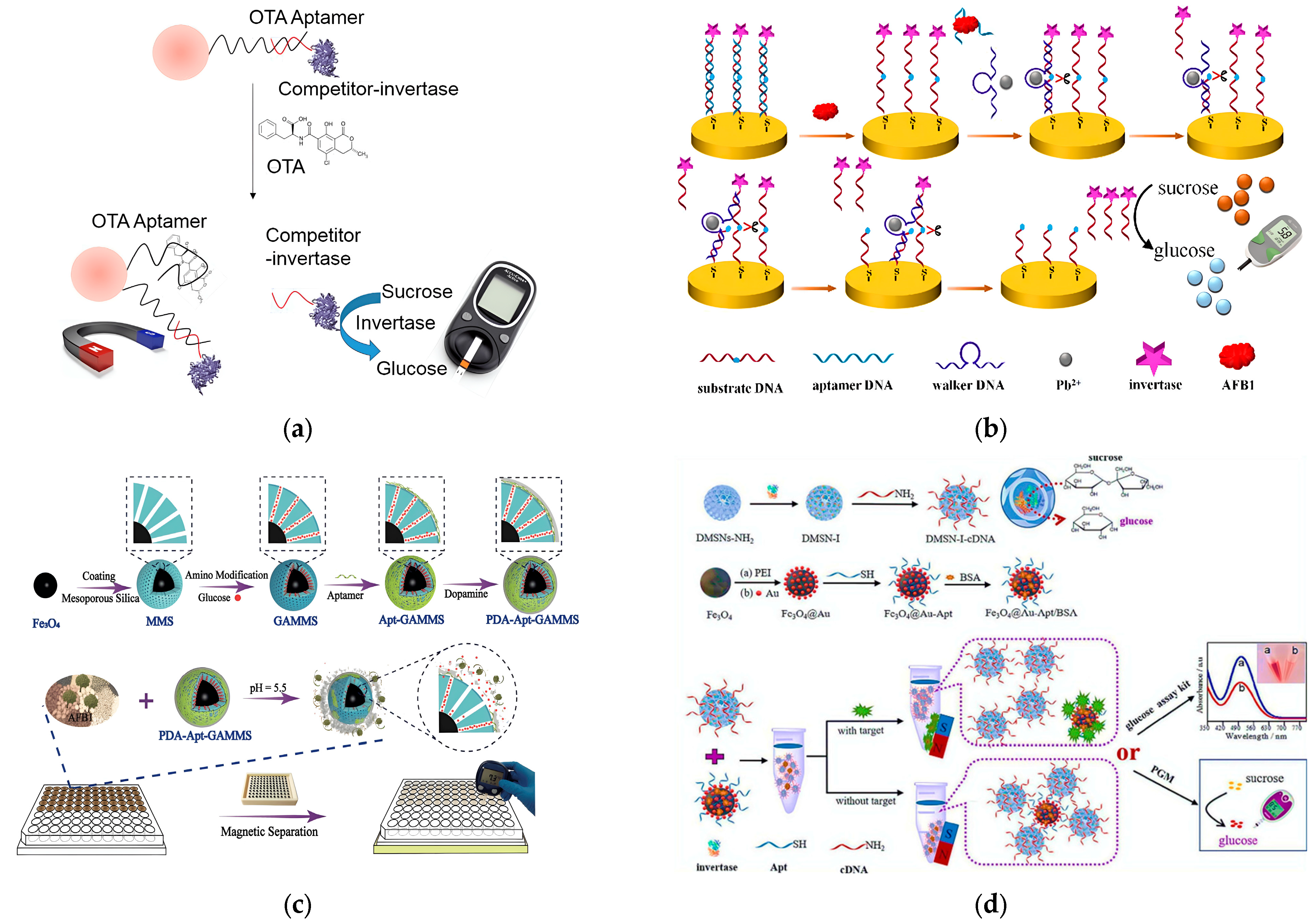
3.2.2. Advanced Nanomaterials as Nanocarriers
3.3. Portable Aptasensors Based on Smartphones
3.3.1. Smartphone-Based Optical Aptasensors
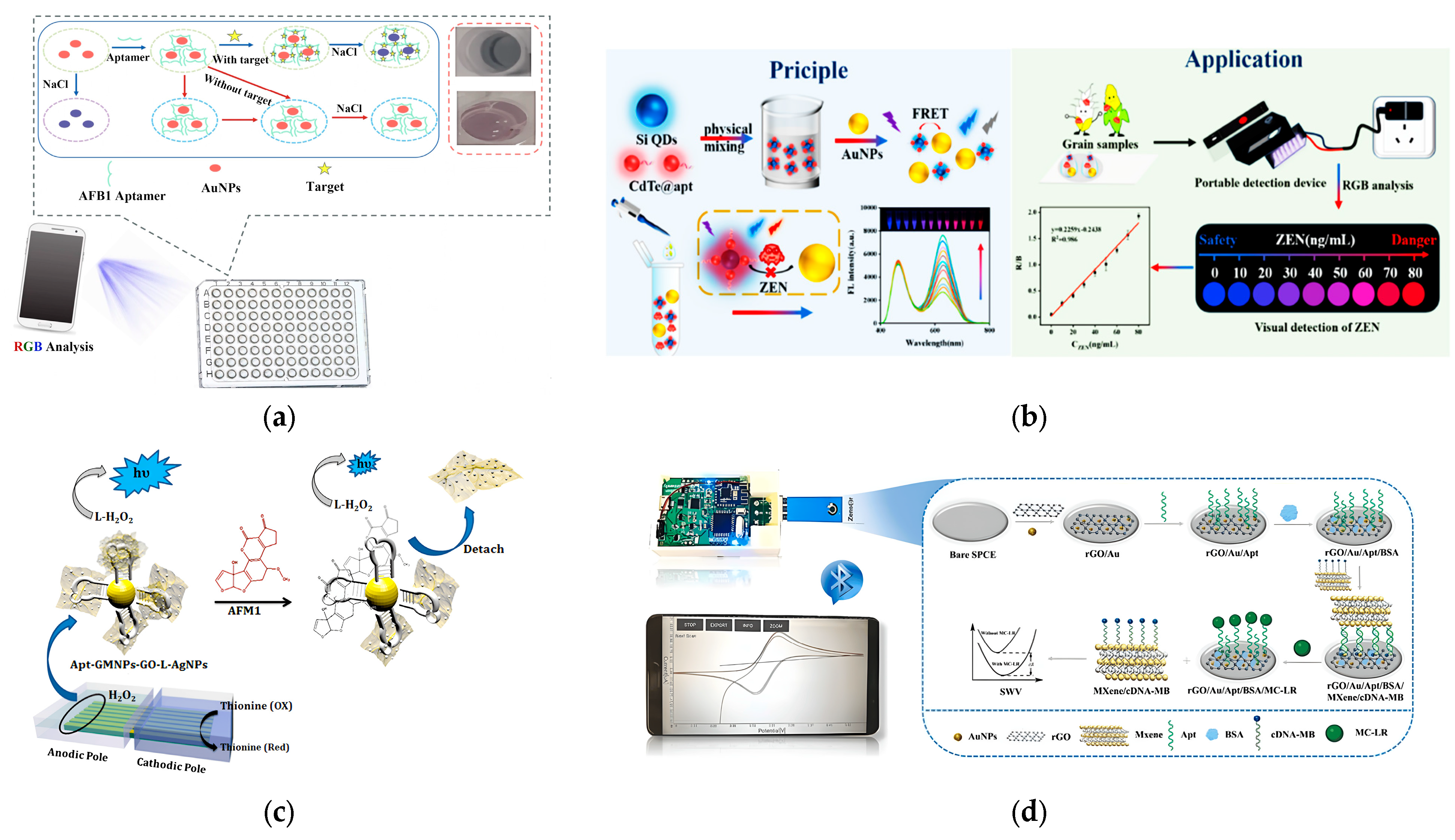
3.3.2. Smartphone-Based Electrochemical Aptasensors
3.4. Other Portable Aptasensors
3.4.1. Pressure Meter-Based Aptasensors
3.4.2. Thermometer-Based Aptasensors
3.4.3. pH Meter-Based Aptasensors
3.4.4. Pregnancy Test Strip-Based Aptasensors
3.4.5. Microfluidic Chip-Based Aptasensors
3.4.6. Portable Potentiostat-Based Aptasensors
4. Discussion
- (1)
- Aptamers, as molecular recognition elements, are significantly more cost-effective and efficient than antibodies. However, despite the identification of over two thousand biotoxins species globally [122], the application of aptamers in portable device-based aptasensors for biotoxin detection remains limited. This underscores the imperative for the selection of more diverse and effective aptamers to broaden the scope of applications.
- (2)
- In many cases, the sensitivity of portable aptasensors is insufficient for detecting biotoxins in complex food or environmental matrices. To realize portable and sensitive applications, integrating signal amplification strategies into these aptasensors is crucial. For example, developing portable aptasensors for biotoxins with amplification techniques such as hybridization chain reaction (HCR), rolling circle amplification (RCA), polymerase chain reaction (PCR), and recombinase polymerase amplification (RPA) presents a promising approach. Additionally, applying advanced nanomaterials can enhance the quantification of ultra-low levels of biotoxins. For example, some crystalline porous nanomaterials have garnered substantial research attention, including hydrogel [123] and metal–organic framework (MOF) [124], due to their promising potential in the development of nanomaterials as nanocarriers for signal amplification.
- (3)
- Continuous monitoring through biosensors is crucial for many sectors, including agriculture and food safety. Achieving continuous biotoxin monitoring is essential for ensuring food safety, understanding contamination patterns, evaluating control measures, and safeguarding public health. Traditional real-time monitoring has primarily focused on metabolites, nutrition-related peptide hormones, and protein biomarkers, as fluctuations in their systemic concentrations provide critical information for guiding real-time clinical interventions [125,126,127,128]. In contrast, real-time detection of biotoxins is a relatively new concept, but it holds significant potential for improving biotoxin monitoring [129]. While aptamer-based biosensors are rarely used for continuous biotoxin monitoring, developing portable aptasensors with POCT capabilities for this purpose is highly desirable. For a portable aptasensor to be truly useful for continuous monitoring, the device must be sufficiently selective to detect biotoxins directly in unfiltered, unadulterated media, and it must exhibit high specificity for the targets.
- (4)
- The functionalization of aptamers onto DNA nanostructures, or origami, has emerged as a powerful approach for developing advanced aptasensors. By providing a stable and rigid platform for aptamer immobilization, DNA nanostructures can enhance the stability, sensitivity, and specificity of these sensors. The precise control over the spatial arrangement of aptamers on the DNA nanostructure allows for the design of multiplexed aptasensors and minimizes crosstalk between different aptamers [130,131]. Moreover, DNA nanostructures can be engineered to incorporate additional functional elements, such as fluorophores or electrochemical tags, enabling signal amplification and further enhancing sensor sensitivity [132]. Numerous instances of aptasensors utilizing DNA nanostructures have been documented [133,134,135]. The unique structure of tetrahedral DNA nanostructures (TDNs) allows for the efficient and rapid binding of target molecules to the electrode surface, resulting in amplified electrochemical signals [136,137]. Additionally, the incorporation of a DNA walker on DNA nanostructures can further improve detection sensitivity, eliminating the high cost and instability associated with enzyme-assisted amplification techniques [138,139]. Nevertheless, the majority of DNA nanostructure-based aptasensors continue to depend on fluorescence or electrochemical workstations for measurement. The functionalization of aptamers onto DNA nanostructures, or origami, constitutes a substantial advancement in the development of aptamer-based sensors. The integration of this methodology with portable devices for the detection of biotoxins is highly desirable.
- (5)
- The market offers a wide array of portable devices, each with its own features, which must be carefully considered. Furthermore, the absence of standardization in this field complicates the comparison of monitoring results across different studies. Standardization is pivotal for the development and validation of portable aptasensors intended for food and environmental safety and hazard analysis. It is also crucial to validate the reliability and accuracy of these aptasensors against established devices and standard approaches.
- (6)
- Most reported portable aptasensors are designed for single biotoxin detection, with only a few capable of multi-analyte detection. Given the coexistence of various biotoxins in food or environmental matrices, it is imperative to develop more portable aptasensors capable of simultaneously monitoring multiple biotoxins in real-world samples. Addressing this challenge should be a priority for future research.
- (7)
- Currently, portable device-based aptasensors have not yet reached commercial availability, and the associated technologies and methodologies are still in the early stages of development. We believe that an electrochemical portable device could represent the ultimate form of aptasensors for biotoxin detection, similar to integrated redox-electro-reactor glucometers. While aptasensors have been widely applied in the field of electrochemistry [140,141,142], it is unfortunate that most current research still relies on electrochemical workstations for detection. The integration of aptasensors with electrochemical principles to develop fully functional portable devices capable of quantitative detection remains a significant challenge.
5. Conclusions
Author Contributions
Funding
Institutional Review Board Statement
Informed Consent Statement
Data Availability Statement
Conflicts of Interest
References
- Tang, X.Q.; Zuo, J.S.; Cheng, Y.; Jiang, J.; Zhang, Q.; Ping, J.F.; Li, P.W. Current trends in biosensors for biotoxins (mycotoxins, marine toxins, and bacterial food toxins): Principles, application, and perspective. TrAC Trends Anal. Chem. 2023, 165, 117144. [Google Scholar] [CrossRef]
- Picardo, M.; Núñez, O.; Farré, M. Suspect and target screening of natural toxins in the ter river catchment area in NE Spain and prioritisation by their toxicity. Toxins 2020, 12, 752. [Google Scholar] [CrossRef] [PubMed]
- Funari, E.; Testai, E. Human health risk assessment related to cyanotoxins exposure. Crit. Rev. Toxicol. 2008, 38, 97–125. [Google Scholar] [CrossRef] [PubMed]
- Inbaraj, B.S.; Chen, B.H. Nanomaterial-based sensors for detection of foodborne bacterial pathogens and toxins as well as pork adulteration in meat products. J. Food Drug Anal. 2016, 24, 15–28. [Google Scholar] [CrossRef]
- Rausch, A.K.; Brockmeyer, R.; Schwerdtle, T. Development and validation of a liquid chromatography tandem mass spectrometry multi-method for the determination of 41 free and modified mycotoxins in beer. Food Chem. 2021, 338, 127801. [Google Scholar] [CrossRef]
- Gago-Martinez, A.; Leao, J.M.; Pineiro, N.; Carballal, E.; Vaquero, E.; Nogueiras, M.; Rodriguez-Vazquez, J.A. An application of capillary electrophoresis for the analysis of algal toxins from the aquatic environment. Int. J. Environ. Anal. Chem. 2003, 83, 443–456. [Google Scholar] [CrossRef]
- Vashist, S.K.; Luppa, P.B.; Yeo, L.Y.; Ozcan, A.; Luong, J.H.T. Emerging Technologies for Next-Generation Point-of-Care Testing. Trends Biotechnol. 2015, 33, 692–705. [Google Scholar] [CrossRef] [PubMed]
- Zhang, M.K.; Guo, X.D.; Wang, J.Q. Advanced biosensors for mycotoxin detection incorporating miniaturized meters. Biosens. Bioelectron. 2023, 224, 115077. [Google Scholar] [CrossRef]
- Dhiman, A.; Kaira, P.; Bansal, V.; Bruno, J.G.; Sharma, T.K. Aptamer-based point-of-care diagnostic platforms. Sens. Actuators B Chem. 2017, 246, 535–553. [Google Scholar] [CrossRef]
- Sadeghi, P.; Sohrabi, H.; Majidi, M.R.; Eftekhari, A.; Zargari, F.; de la Guardia, M.; Mokhtarzadeh, A.A. Mycotoxins detection in food samples through lateral flow assays (LFAs)-An update for status and prospect. TrAC Trends Anal. Chem. 2024, 176, 117722. [Google Scholar] [CrossRef]
- Kadam, U.S.; Hong, J.C. Advances in aptameric biosensors designed to detect toxic contaminants from food, water, human fluids, and the environment. Trends Environ. Anal. Chem. 2022, 36, e00184. [Google Scholar] [CrossRef]
- Zheng, X.; Gao, S.X.; Wu, J.H.; Hu, X.B. Recent Advances in Aptamer-Based Biosensors for Detection of Pseudomonas aeruginosa. Front. Microbiol. 2020, 11, 605229. [Google Scholar] [CrossRef] [PubMed]
- Zhao, Y.; Li, L.; Yan, X.; Wang, L.; Ma, R.; Qi, X.; Wang, S.; Mao, X. Emerging roles of the aptasensors as superior bioaffinity sensors for monitoring shellfish toxins in marine food chain. J. Hazard. Mater. 2022, 421, 126690. [Google Scholar] [CrossRef] [PubMed]
- Bilibana, M.P.; Citartan, M.; Fuku, X.; Jijana, A.N.; Mathumba, P.; Iwuoha, E. Aptamers functionalized hybrid nanomaterials for algal toxins detection and decontamination in aquatic system: Current progress, opportunities, and challenges. Ecotoxicol. Environ. Saf. 2022, 232, 113249. [Google Scholar] [CrossRef]
- Shkembi, X.; Svobodova, M.; Skouridou, V.; Bashammakh, A.S.; Alyoubi, A.O.; O’Sullivan, C.K. Aptasensors for mycotoxin detection: A review. Anal. Biochem. 2022, 644, 114156. [Google Scholar] [CrossRef]
- Zahraee, H.; Mehrzad, A.; Abnous, K.; Chen, C.H.; Khoshbin, Z.; Verdian, A. Recent Advances in Aptasensing Strategies for Monitoring Phycotoxins: Promising for Food Safety. Biosensors 2022, 13, 56. [Google Scholar] [CrossRef]
- Chen, Y.J.; Tsai, C.Y.; Hu, W.P.; Chang, L.S. DNA Aptamers against Taiwan Banded Krait α-Bungarotoxin Recognize Taiwan Cobra Cardiotoxins. Toxins 2016, 8, 66. [Google Scholar] [CrossRef]
- Averin, A.S.; Utkin, Y.N. Cardiovascular Effects of Snake Toxins: Cardiotoxicity and Cardio-protection. Acta Naturae 2021, 13, 4–14. [Google Scholar] [CrossRef]
- Olsnes, S.; Refsnes, K.; Pihl, A. Mechanism of action of the toxic lectins abrin and ricin. Nature 1974, 249, 627–631. [Google Scholar] [CrossRef]
- Abbas, H.K.; Shier, W.T.; Horn, B.W.; Weaver, M.A. Cultural Methods for Aflatoxin Detection. J. Toxicol. Toxin Rev. 2004, 23, 295–315. [Google Scholar] [CrossRef]
- Tao, Y.F.; Xie, S.Y.; Xu, F.F.; Liu, A.M.; Wang, Y.X.; Chen, D.M.; Pan, Y.H.; Huang, L.L.; Peng, D.P.; Wang, X.; et al. Ochratoxin A: Toxicity, oxidative stress and metabolism. Food Chem. Toxicol. 2018, 112, 320–331. [Google Scholar] [CrossRef]
- Han, X.; Huangfu, B.X.; Xu, T.X.; Xu, W.T.; Asakiya, C.; Huang, K.L.; He, X.Y. Research Progress of Safety of Zearalenone: A Review. Toxins 2022, 14, 386. [Google Scholar] [CrossRef] [PubMed]
- Hobbs, R.J.; Thomas, C.A.; Halliwell, J.; Gwenin, C.D. Rapid Detection of Botulinum Neurotoxins—A Review. Toxins 2019, 11, 418. [Google Scholar] [CrossRef] [PubMed]
- Wu, S.J.; Duan, N.; Gu, H.J.; Hao, L.L.; Ye, H.; Gong, W.H.; Wang, Z.P. A Review of the Methods for Detection of Staphylococcus aureus Enterotoxins. Toxins 2016, 8, 176. [Google Scholar] [CrossRef] [PubMed]
- Cusick, K.D.; Sayler, G.S. An Overview on the Marine Neurotoxin, Saxitoxin: Genetics, Molecular Targets, Methods of Detection and Ecological Functions. Mar. Drugs 2013, 11, 991–1018. [Google Scholar] [CrossRef]
- Fu, L.L.; Zhao, X.Y.; Ji, L.D.; Xu, J. Okadaic acid (OA): Toxicity, detection and detoxification. Toxicon 2019, 160, 1–7. [Google Scholar] [CrossRef]
- Pasinszki, T.; Lako, J.; Dennis, T.E. Advances in Detecting Ciguatoxins in Fish. Toxins 2020, 12, 494. [Google Scholar] [CrossRef]
- Bane, V.; Lehane, M.; Dikshit, M.; O’Riordan, A.; Furey, A. Tetrodotoxin: Chemistry, Toxicity, Source, Distribution and Detection. Toxins 2014, 6, 693–755. [Google Scholar] [CrossRef] [PubMed]
- Carlin, M.; Pelin, M.; Ponti, C.; Sosa, S.; Tubaro, A. Functional and Structural Biological Methods for Palytoxin Detection. J. Mar. Sci. Eng. 2022, 10, 916. [Google Scholar] [CrossRef]
- Ye, W.; Liu, T.M.; Zhang, W.M.; Zhu, M.Z.; Liu, Z.M.; Kong, Y.L.; Liu, S. Marine Toxins Detection by Biosensors Based on Aptamers. Toxins 2020, 12, 1. [Google Scholar] [CrossRef]
- Tuerk, C.; Gold, L. Systematic Evolution of Ligands by Exponential Enrichment: RNA Ligands to Bacteriophage T4 DNA Polymerase. Science 1990, 249, 505–510. [Google Scholar] [CrossRef] [PubMed]
- Ellington, A.D.; Szostak, J.W. In vitro selection of RNA molecules that bind specific ligands. Nature 1990, 346, 818–822. [Google Scholar] [CrossRef]
- Jenison, R.D.; Gill, S.C.; Pardi, A.; Polisky, B. High-resolution molecular discrimination by RNA. Science 1994, 263, 1425–1429. [Google Scholar] [CrossRef] [PubMed]
- Phopin, K.; Tantimongcolwat, T. Pesticide Aptasensors-State of the Art and Perspectives. Sensors 2020, 20, 6809. [Google Scholar] [CrossRef]
- Zhuo, Z.; Yu, Y.; Wang, M.; Li, J.; Zhang, Z.; Liu, J.; Wu, X.; Lu, A.; Zhang, G.; Zhang, B. Recent Advances in SELEX Technology and Aptamer Applications in Biomedicine. Int. J. Mol. Sci. 2017, 18, 2142. [Google Scholar] [CrossRef] [PubMed]
- Yüce, M.; Ullah, N.; Budak, H. Trends in aptamer selection methods and applications. Analyst 2015, 140, 5379–5399. [Google Scholar] [CrossRef] [PubMed]
- Zhou, L.L.; Li, P.F.; Yang, M.; Yu, Y.P.; Huang, Y.H.; Wei, J.G.; Wei, S.; Qin, Q.W. Generation and characterization of novel DNA aptamers against coat protein of grouper nervous necrosis virus (GNNV) with antiviral activities and delivery potential in grouper cells. Antivir. Res. 2016, 129, 104–114. [Google Scholar] [CrossRef]
- Bruno, J.G. In vitro selection of DNA to chloroaromatics using magnetic microbead-based affinity separation and fluorescence detection. Biochem. Biophys. Res. Commun. 1997, 234, 117–120. [Google Scholar] [CrossRef]
- Zhu, C.; Feng, Z.R.; Qin, H.W.; Chen, L.; Yan, M.M.; Li, L.S.; Qu, F. Recent progress of SELEX methods for screening nucleic acid aptamers. Talanta 2024, 266, 124998. [Google Scholar] [CrossRef]
- Guo, H.; Deng, B.W.; Zhao, L.M.; Gao, Y.; Zhang, X.J.; Yang, C.F.; Zou, B.; Chen, H.; Sun, M.J.; Wang, L.H.; et al. Programmed Aptamer Screening, Characterization, and Rapid Detection for alpha-Conotoxin MI. Toxins 2022, 14, 706. [Google Scholar] [CrossRef]
- Frohnmeyer, E.; Frisch, F.; Falke, S.; Betzel, C.; Fischer, M. Highly affine and selective aptamers against cholera toxin as capture elements in magnetic bead-based sandwich ELAA. J. Biotechnol. 2018, 269, 35–42. [Google Scholar] [CrossRef] [PubMed]
- Li, L.; Zhao, Y.L.; Yan, X.C.; Qi, X.Y.; Wang, L.L.; Ma, R.; Wang, S.; Mao, X.Z. Development of a terminal-fixed aptamer and a label-free colorimetric aptasensor for highly sensitive detection of saxitoxin. Sens. Actuators B 2021, 344, 130320. [Google Scholar] [CrossRef]
- Yang, Y.; Yin, Y.G.; Li, X.L.; Wang, S.; Dong, Y.Y. Development of a chimeric aptamer and an AuNPs aptasensor for highly sensitive and specific identification of Aflatoxin B1. Sens. Actuators B 2020, 319, 128250. [Google Scholar] [CrossRef]
- Gao, S.X.; Zheng, X.; Hu, B.; Sun, M.J.; Wu, J.H.; Jiao, B.H.; Wang, L.H. Enzyme-linked, aptamer-based, competitive biolayer interferometry biosensor for palytoxin. Biosens. Bioelectron. 2017, 89, 952–958. [Google Scholar] [CrossRef] [PubMed]
- Yan, J.; Xiong, H.; Cai, S.; Wen, N.; He, Q.; Liu, Y.; Peng, D.; Liu, Z. Advances in aptamer screening technologies. Talanta 2019, 200, 124–144. [Google Scholar] [CrossRef] [PubMed]
- Khatri, K.; Klein, J.A.; Haserick, J.R.; Leon, D.R.; Costello, C.E.; McComb, M.E.; Zaia, J. Microfluidic Capillary Electrophoresis Mass Spectrometry for Analysis of Monosaccharides, Oligosaccharides, and Glycopeptides. Anal. Chem. 2017, 89, 6645–6655. [Google Scholar] [CrossRef]
- Yang, J.; Bowser, M.T. Capillary Electrophoresis-SELEX Selection of Catalytic DNA Aptamers for a Small-Molecule Porphyrin Target. Anal. Chem. 2013, 85, 1525–1530. [Google Scholar] [CrossRef]
- Chen, Z.; Yang, Y.; Cui, X.; Chai, L.; Liu, H.; Pan, Y.; Zhang, Y.; Xie, Y.; Le, T. Process, advances, and perspectives of graphene oxide-SELEX for the development of aptamer molecular probes: A comprehensive review. Anal. Chim. Acta 2024, 1320, 343004. [Google Scholar] [CrossRef]
- Stojanovic, M.N.; de Prada, P.; Landry, D.W. Fluorescent Sensors Based on Aptamer Self-Assembly. Chem. Soc. 2000, 122, 11547–11548. [Google Scholar] [CrossRef]
- Xiao, Y.; Lubin, A.A.; Heeger, A.J.; Plaxco, K.W. Label-free electronic detection of thrombin in blood serum by using an aptamer-based sensor. Chem. Int. Ed. 2005, 44, 5456–5459. [Google Scholar] [CrossRef]
- Nie, J.; Deng, Y.; Deng, Q.P.; Zhang, D.W.; Zhou, Y.L.; Zhang, X.X. A self-assemble aptamer fragment/target complex based high-throughput colorimetric aptasensor using enzyme linked aptamer assay. Talanta 2013, 106, 309–314. [Google Scholar] [CrossRef] [PubMed]
- Gao, S.X.; Hu, B.; Zheng, X.; Cao, Y.; Liu, D.J.; Sun, M.J.; Jiao, B.H.; Wang, L.H. Gonyautoxin 1/4 aptamers with high-affinity and high-specificity: From efficient selection to aptasensor application. Biosens. Bioelectron. 2016, 79, 938–944. [Google Scholar] [CrossRef] [PubMed]
- Zhang, X.J.; Gao, Y.; Deng, B.W.; Hu, B.; Zhao, L.M.; Guo, H.; Yang, C.F.; Ma, Z.X.; Sun, M.J.; Jiao, B.H.; et al. Selection, Characterization, and Optimization of DNA Aptamers against Challenging Marine Biotoxin Gymnodimine-A for Biosensing Application. Toxins 2022, 14, 195. [Google Scholar] [CrossRef]
- Wu, S.J.; Duan, N.O.; Zhang, W.X.; Zhao, S.; Wang, Z.P. Screening and development of DNA aptamers as capture probes for colorimetric detection of patulin. Anal. Biochem. 2016, 508, 58–64. [Google Scholar] [CrossRef]
- Chen, X.J.; Huang, Y.K.; Duan, N.; Wu, S.J.; Xia, Y.; Ma, X.Y.; Zhu, C.Q.; Jiang, Y.; Wang, Z.P. Screening and Identification of DNA Aptamers against T-2 Toxin Assisted by Graphene Oxide. J. Agric. Food Chem. 2014, 62, 10368–10374. [Google Scholar] [CrossRef]
- Mukherjee, M.; Sistla, S.; Veerabhadraiah, S.R.; Bettadaiah, B.K.; Thakur, M.S.; Bhatt, P. DNA aptamer selection and detection of marine biotoxin 20 Methyl Spirolide G. Food Chem. 2021, 363, 130332. [Google Scholar] [CrossRef]
- Eissa, S.; Ng, A.; Siaj, M.; Tavares, A.C.; Zourob, M. Selection and Identification of DNA Aptamers against Okadaic Acid for Biosensing Application. Anal. Chem. 2013, 85, 11794–11801. [Google Scholar] [CrossRef] [PubMed]
- Ng, A.; Chinnappan, R.; Eissa, S.; Liu, H.C.; Tlili, C.; Zourob, M. Selection, Characterization, and Biosensing Application of High Affinity Congener-Specific Microcystin-Targeting Aptamers. Environ. Sci. Technol. 2012, 46, 10697–10703. [Google Scholar] [CrossRef]
- Zhang, Y.Y.; Lu, T.F.; Wang, Y.; Diao, C.X.; Zhou, Y.; Zhou, L.L.; Chen, H.Y. Selection of a DNA Aptamer against Zearalenone and Docking Analysis for Highly Sensitive Rapid Visual Detection with Label-Free Aptasensor. J. Agric. Food Chem. 2018, 66, 12102–12110. [Google Scholar] [CrossRef]
- Lamont, E.A.; He, L.; Warriner, K.; Labuza, T.P.; Sreevatsan, S. A single DNA aptamer functions as a biosensor for ricin. Analyst 2011, 136, 3884–3895. [Google Scholar] [CrossRef]
- Fetter, L.; Richards, J.; Daniel, J.; Roon, L.; Rowland, T.J.; Bonham, A.J. Electrochemical aptamer scaffold biosensors for detection of botulism and ricin toxins. Chem. Commun. 2015, 51, 15137–15140. [Google Scholar] [CrossRef] [PubMed]
- Huang, Y.K.; Chen, X.J.; Xia, Y.; Wu, S.J.; Duan, N.; Ma, X.Y.; Wang, Z.P. Selection, identification and application of a DNA aptamer against Staphylococcus aureus enterotoxin A. Anal. Methods 2014, 6, 690–697. [Google Scholar] [CrossRef]
- Jaisankar, A.; Krishnan, S.; Rangasamy, L. Recent developments of aptamer-based lateral flow assays for point-of-care (POC) diagnostics. Anal. Biochem. 2022, 655, 114874. [Google Scholar] [CrossRef] [PubMed]
- Bahadir, E.B.; Sezginturk, M.K. Lateral flow assays: Principles, designs and labels. TrAC Trends Anal. Chem. 2016, 82, 286–306. [Google Scholar] [CrossRef]
- Zhou, W.L.; Kong, W.J.; Dou, X.W.; Zhao, M.; Ouyang, Z.; Yang, M.H. An aptamer based lateral flow strip for on-site rapid detection of ochratoxin A in Astragalus membranaceus. J. Chromatogr. B Anal. Technol. Biomed. Life Sci. 2016, 1022, 102–108. [Google Scholar] [CrossRef]
- Feng, J.L.; Wu, Y.Y.; Zhang, J.; Jin, R.Y.; Li, Y.L.; Shen, Q. An aptamer lateral flow assay for visual detection of Microcystins-LR residue in fish. J. Food Compos. Anal. 2023, 115, 105012. [Google Scholar] [CrossRef]
- Mousivand, M.; Javan-Nikkhah, M.; Anfossi, L.; Di Nardo, F.; Salina, M.; Bagherzadeh, K. High performance aptasensing platform development through in silico aptamer engineering for aflatoxin B1 monitoring. Food Control 2023, 145, 109418. [Google Scholar] [CrossRef]
- Zhu, X.; Tang, J.; Ouyang, X.L.; Liao, Y.B.; Feng, H.P.; Yu, J.F.; Chen, L.; Lu, Y.T.; Yi, Y.Y.; Tang, L. A versatile CuCo@PDA nanozyme-based aptamer-mediated lateral flow assay for highly sensitive, on-site and dual-readout detection of Aflatoxin B1. J. Hazard. Mater. 2024, 465, 133178. [Google Scholar] [CrossRef]
- Zhang, G.L.; Zhu, C.; Huang, Y.F.; Yan, J.; Chen, A.L. A Lateral Flow Strip Based Aptasensor for Detection of Ochratoxin A in Corn Samples. Molecules 2018, 23, 291. [Google Scholar] [CrossRef]
- Zhao, Z.L.; Wang, H.; Zhai, W.L.; Feng, X.Y.; Fan, X.; Chen, A.L.; Wang, M. A Lateral Flow Strip Based on a Truncated Aptamer-Complementary Strand for Detection of Type-B Aflatoxins in Nuts and Dried Figs. Toxins 2020, 12, 136. [Google Scholar] [CrossRef]
- Zhu, C.; Zhang, G.L.; Huang, Y.F.; Yang, S.M.; Ren, S.Y.; Gao, Z.X.; Chen, A.L. Dual-competitive lateral flow aptasensor for detection of aflatoxin B1 in food and feedstuffs. J. Hazard. Mater. 2018, 344, 249–257. [Google Scholar] [CrossRef]
- Sapountzi, E.A.; Tragoulias, S.S.; Kalogianni, D.P.; Ioannou, P.C.; Christopoulos, T.K. Lateral flow devices for nucleic acid analysis exploiting quantum dots as reporters. Anal. Chim. Acta 2015, 846, 48–54. [Google Scholar] [CrossRef]
- Wang, L.B.; Chen, W.; Ma, W.W.; Liu, L.Q.; Ma, W.; Zhao, Y.A.; Zhu, Y.Y.; Xu, L.G.; Kuang, H.; Xu, C.L. Fluorescent strip sensor for rapid determination of toxins. Chem. Commun. 2011, 47, 1574–1576. [Google Scholar] [CrossRef]
- Bruno, J.G.; Richarte, A. Aptamer-Quantum Dot Lateral Flow Test Strip Development for Rapid and Sensitive Detection of Pathogenic Escherichia coli via Intimin, O157-Specific LPS and Shiga Toxin 1 Aptamers. Curr. Bionanotechnol. 2015, 1, 80–86. [Google Scholar] [CrossRef]
- Wang, L.Y.; Yan, R.X.; Hao, Z.Y.; Wang, L.; Zeng, J.H.; Bao, J.; Wang, X.; Peng, Q.; Li, Y.D. Fluorescence resonant energy transfer biosensor based on upconversion-luminescent nanoparticles. Angew. Chem. Int. Ed. 2005, 44, 6054–6057. [Google Scholar] [CrossRef]
- Zhou, J.; Liu, Q.; Feng, W.; Sun, Y.; Li, F.Y. Upconversion Luminescent Materials: Advances and Applications. Chem. Rev. 2015, 115, 395–465. [Google Scholar] [CrossRef]
- Zhou, B.; Shi, B.Y.; Jin, D.Y.; Liu, X.G. Controlling upconversion nanocrystals for emerging applications. Nat. Nanotechnol. 2015, 10, 924–936. [Google Scholar] [CrossRef]
- Wu, S.J.; Liu, L.H.; Duan, N.; Wang, W.Y.; Yu, Q.R.; Wang, Z.P. A test strip for ochratoxin A based on the use of aptamer-modified fluorescence upconversion nanoparticles. Microchim. Acta 2018, 185, 497. [Google Scholar] [CrossRef]
- Jin, B.R.; Yang, Y.X.; He, R.Y.; Park, Y.I.; Lee, A.; Bai, D.; Li, F.; Lu, T.J.; Xu, F.; Lin, M. Lateral flow aptamer assay integrated smartphone-based portable device for simultaneous detection of multiple targets using upconversion nanoparticles. Sens. Actuators B 2018, 276, 48–56. [Google Scholar] [CrossRef]
- Jin, B.R.; Li, Z.D.; Zhao, G.X.; Ji, J.C.; Chen, J.; Yang, Y.X.; Xu, R. Upconversion fluorescence-based paper disc for multiplex point-of-care testing in water quality monitoring. Anal. Chim. Acta 2022, 1192, 339388. [Google Scholar] [CrossRef]
- Xiao, W.C.; Gao, Y.M.; Zhang, Y.; Li, J.; Liu, Z.Y.; Nie, J.F.; Li, J.P. Enhanced 3D paper-based devices with a personal glucose meter for highly sensitive and portable biosensing of silver ion. Biosens. Bioelectron. 2019, 137, 154–160. [Google Scholar] [CrossRef]
- Gu, C.M.; Long, F.; Zhou, X.H.; Shi, H.C. Portable detection of ochratoxin A in red wine based on a structure-switching aptamer using a personal glucometer. RSC Adv. 2016, 6, 29563–29569. [Google Scholar] [CrossRef]
- Qiu, S.Y.; Yuan, L.J.; Wei, Y.H.; Zhang, D.W.; Chen, Q.L.; Lin, Z.Y.; Luo, L.G. DNA template-mediated click chemistry-based portable signal-on sensor for ochratoxin A detection. Food Chem. 2019, 297, 124929. [Google Scholar] [CrossRef]
- Yang, X.S.; Shi, D.M.; Zhu, S.M.; Wang, B.J.; Zhang, X.J.; Wang, G.F. Portable Aptasensor of Aflatoxin B1 in Bread Based on a Personal Glucose Meter and DNA Walking Machine. ACS Sens. 2018, 3, 1368–1375. [Google Scholar] [CrossRef]
- Zhang, S.B.; Luan, Y.X.; Xiong, M.Y.; Zhang, J.J.; Lake, R.; Lu, Y. DNAzyme Amplified Aptasensing Platform for Ochratoxin A Detection Using a Personal Glucose Meter. ACS Appl. Mater. Interfaces 2021, 13, 9472–9481. [Google Scholar] [CrossRef]
- Wang, L.M.; Zhu, F.W.; Chen, M.; Xiong, Y.; Zhu, Y.Q.; Xie, S.Q.; Liu, Q.; Yang, H.; Chen, X.Q. Development of a “Dual Gates” Locked, Target-Triggered Nanodevice for Point-of-Care Testing with a Glucometer Readout. ACS Sens. 2019, 4, 968–976. [Google Scholar] [CrossRef]
- Yang, L.T.; Wang, Y.; Yao, C.; Xu, X. Highly sensitive and portable aptasensor by using enzymatic nanoreactors as labels. Microchem. J. 2021, 168, 106407. [Google Scholar] [CrossRef]
- Rezazadeh, M.; Seidi, S.; Lid, M.; Pedersen-Bjergaard, S.; Yamini, Y. The modern role of smartphones in analytical chemistry. TrAC Trends Anal. Chem. 2019, 118, 548–555. [Google Scholar] [CrossRef]
- Zahra, Q.U.; Khan, Q.A.; Luo, Z.F. Advances in Optical Aptasensors for Early Detection and Diagnosis of Various Cancer Types. Front. Oncol. 2021, 11, 632165. [Google Scholar] [CrossRef]
- Zahra, Q.U.; Luo, Z.F.; Ali, R.; Khan, M.I.; Li, F.F.; Qiu, B.S. Advances in Gold Nanoparticles-Based Colorimetric Aptasensors for the Detection of Antibiotics: An Overview of the Past Decade. Nanomaterials 2021, 11, 840. [Google Scholar] [CrossRef]
- Zahra, Q.U.; Ullah, S.; Shahzad, F.; Qiu, B.S.; Fang, X.A.; Ammar, A.; Luo, Z.F.; Zaidi, S.A. MXene-based aptasensors: Advances, challenges, and prospects. Prog. Mater. Sci. 2022, 129, 100967. [Google Scholar] [CrossRef]
- Zahra, Q.U.; Fang, X.A.; Luo, Z.F.; Ullah, S.; Fatima, S.; Batool, S.; Qiu, B.S.; Shahzad, F. Graphene Based Nanohybrid Aptasensors in Environmental Monitoring: Concepts, Design and Future Outlook. Crit. Rev. Anal. Chem. 2022, 27, 1433–1454. [Google Scholar] [CrossRef] [PubMed]
- Wang, L.J.; Chang, Y.C.; Sun, R.R.; Li, L. A multichannel smartphone optical biosensor for high-throughput point-of-care diagnostics. Biosens. Bioelectron. 2017, 87, 686–692. [Google Scholar] [CrossRef]
- Geng, Z.X.; Zhang, X.; Fan, Z.Y.; Lv, X.Q.; Su, Y.; Chen, H.D. Recent Progress in Optical Biosensors Based on Smartphone Platforms. Sensors 2017, 17, 2449. [Google Scholar] [CrossRef]
- Liu, Z.G.; Zhang, Y.L.; Xu, S.J.; Zhang, H.; Tan, Y.X.; Ma, C.M.; Song, R.; Jiang, L.L.; Yi, C.Q. A 3D printed smartphone optosensing platform for point-of-need food safety inspection. Anal. Chim. Acta 2017, 966, 81–89. [Google Scholar] [CrossRef]
- Kim, S.D.; Koo, Y.; Yun, Y. A Smartphone-Based Automatic Measurement Method for Colorimetric pH Detection Using a Color Adaptation Algorithm. Sensors 2017, 17, 1604. [Google Scholar] [CrossRef]
- Ma, X.Y.; Guo, Z.Z.; Mao, Z.Q.; Tang, Y.G.; Miao, P. Colorimetric theophylline aggregation assay using an RNA aptamer and non-crosslinking gold nanoparticles. Microchim. Acta 2018, 185, 33. [Google Scholar] [CrossRef]
- Lu, L.F.; Yu, R.Z.; Zhang, L.Y. AFB1 colorimetric aptamer sensor for the detection of AFB1 in ten different kinds of miscellaneous beans based on gold nanoparticles and smartphone imaging. Food Chem. 2023, 421, 136205. [Google Scholar] [CrossRef]
- Zheng, Y.T.; Zhao, B.S.; Zhang, H.B.; Jia, H.; Wu, M.S. Colorimetric aptasensor for fumonisin B1 detection by regulating the amount of bubbles in closed bipolar platform. J. Electroanal. Chem. 2020, 877, 114584. [Google Scholar] [CrossRef]
- Umrao, S.; Anusha, S.; Jain, V.; Chakraborty, B.; Roy, R. Smartphone-based kanamycin sensing with ratiometric FRET. RSC Adv. 2019, 9, 6143–6151. [Google Scholar] [CrossRef]
- Lin, X.F.; Li, C.X.; Tong, X.Y.; Duan, N.; Wang, Z.P.; Wu, S.J. A portable paper-based aptasensor for simultaneous visual detection of two mycotoxins in corn flour using dual-color upconversion nanoparticles and Cu-TCPP nanosheets. Food Chem. 2022, 404, 134750. [Google Scholar] [CrossRef] [PubMed]
- Song, L.J.; Lu, M.J.; Liang, P.Y.; Li, T.G.; Huang, X.Q.; Ma, Y.; Wan, L.B.; Wang, T.L. Smartphone-assisted ratiometric FRET aptasensor based on quantum dots and gold nanoparticles for point-of-care testing of zearalenone in cereals. Food Control 2024, 165, 110666. [Google Scholar] [CrossRef]
- Khoshfetrat, S.M.; Bagheri, H.; Mehrgardi, M.A. Visual electrochemiluminescence biosensing of aflatoxin M1 based on luminol-functionalized, silver nanoparticle-decorated graphene oxide. Biosens. Bioelectron. 2018, 100, 382–388. [Google Scholar] [CrossRef] [PubMed]
- Fan, L.; Huang, J.J.; Liao, J.J. Competitive smartphone-based portable electrochemical aptasensor system based on an MXene/cDNA-MB probe for the determination of Microcystin-LR. Sens. Actuators B 2022, 369, 132164. [Google Scholar] [CrossRef]
- Zhang, D.M.; Liu, Q.J. Biosensors and bioelectronics on smartphone for portable biochemical detection. Biosens. Bioelectron. 2016, 75, 273–284. [Google Scholar] [CrossRef]
- Yao, Y.; Jiang, C.M.; Ping, J.F. Flexible freestanding graphene paper-based potentiometric enzymatic aptasensor for ultrasensitive wireless detection of kanamycin. Biosens. Bioelectron. 2019, 123, 178–184. [Google Scholar] [CrossRef]
- Liu, D.; Jia, S.S.; Zhang, H.M.; Ma, Y.L.; Guan, Z.C.; Li, J.X.; Zhu, Z.; Ji, T.H.; Yang, C.J. Integrating Target-Responsive Hydrogel with Pressuremeter Readout Enables Simple, Sensitive, User-Friendly, Quantitative Point-of-Care Testing. ACS Appl. Mater. Interfaces 2017, 9, 22252–22258. [Google Scholar] [CrossRef]
- Tang, L.Y.; Huang, Y.Y.; Lin, C.Y.; Qiu, B.; Guo, L.H.; Luo, F.; Lin, Z.Y. Highly sensitive and selective aflatoxin B-1 biosensor based on Exonuclease I-catalyzed target recycling amplification and targeted response aptamer-crosslinked hydrogel using electronic balances as a readout. Talanta 2020, 214, 120862. [Google Scholar] [CrossRef]
- Li, X.; Yang, L.; Men, C.; Xie, Y.F.; Liu, J.J.; Zou, H.Y.; Li, Y.F.; Zhan, L.; Huang, C.Z. Photothermal Soft Nanoballs Developed by Loading Plasmonic Cu2−xSe Nanocrystals into Liposomes for Photothermal Immunoassay of Aflatoxin B-1. Anal. Chem. 2019, 91, 4444–4450. [Google Scholar] [CrossRef]
- Zhao, M.M.; Wang, P.L.; Guo, Y.J.; Wang, L.X.; Luo, F.; Qiu, B.; Guo, L.H.; Su, X.O.; Lin, Z.Y.; Chen, G.N. Detection of aflatoxin B1 in food samples based on target-responsive aptamer-cross-linked hydrogel using a handheld pH meter as readout. Talanta 2018, 176, 34–39. [Google Scholar] [CrossRef]
- Zhong, Z.T.; Song, L.B.; He, Y.F.; Zhang, B.; Chen, W.; Liu, B.; Zhao, Y.D. Detection of multiple mycotoxins based on catalytic hairpin assembly coupled with pregnancy test strip. Sens. Actuators B 2022, 350, 130911. [Google Scholar] [CrossRef]
- Liu, R.D.; Huang, Y.S.; Ma, Y.L.; Jia, S.S.; Gao, M.X.; Li, J.X.; Zhang, H.M.; Xu, D.M.; Wu, M.; Yan, C.; et al. Design and Synthesis of Target-Responsive Aptamer-Cross-linked Hydrogel for Visual Quantitative Detection of Ochratoxin A. ACS Appl. Mater. Interfaces 2015, 7, 6982–6990. [Google Scholar] [CrossRef] [PubMed]
- Lu, D.; Jiang, H.; Zhang, G.Y.; Luo, Q.; Zhao, Q.; Shi, X.B. An In Situ Generated Prussian Blue Nanoparticle-Mediated Multimode Nanozyme-Linked Immunosorbent Assay for the Detection of Aflatoxin B1. ACS Appl. Mater. Interfaces 2021, 13, 25738–25747. [Google Scholar] [CrossRef] [PubMed]
- Kwon, D.; Joo, J.; Lee, S.; Jeon, S. Facile and Sensitive Method for Detecting Cardiac Markers using Ubiquitous pH Meters. Anal. Chem. 2014, 85, 12134–12137. [Google Scholar] [CrossRef]
- Tram, K.; Kanda, P.; Salena, B.J.; Huan, S.Y.; Li, Y.F. Translating Bacterial Detection by DNAzymes into a Litmus Test. Angew. Chem. Int. Ed. Engl. 2014, 53, 12799–12802. [Google Scholar] [CrossRef]
- Zhang, Y.; Yang, J.N.; Nie, J.F.; Yang, J.H.; Gao, D.; Zhang, L.; Li, J.P. Enhanced ELISA using a handheld pH meter and enzyme-coated microparticles for the portable, sensitive detection of proteins. Chem. Commun. 2016, 52, 3474–3477. [Google Scholar] [CrossRef]
- Ma, Y.L.; Mao, Y.; Huang, D.; He, Z.; Yan, J.M.; Tian, T.; Shi, Y.Z.; Song, Y.L.; Li, X.R.; Zhu, Z.; et al. Portable visual quantitative detection of aflatoxin B1 using a target-responsive hydrogel and a distance-readout microfluidic chip. Lab A Chip 2016, 16, 3097–3104. [Google Scholar] [CrossRef]
- Ramalingam, S.; Chand, R.; Singh, C.B.; Singh, A. Phosphorene-gold nanocomposite based microfluidic aptasensor for the detection of okadaic acid. Biosens. Bioelectron. 2019, 135, 14–21. [Google Scholar] [CrossRef]
- Liu, L.Q.; Qiu, Y.; Zou, Y.; Feng, X.J.; Gu, Y.; Hao, N.; Wang, K. A Visual Biosensor Chip Based on the Enhanced Electrochemiluminescence with Low Triggered Potential for Ochratoxin A Detection. Sens. Actuators B 2024, 420, 136461. [Google Scholar] [CrossRef]
- He, L.Y.; Shen, Z.P.; Wang, J.Q.; Zeng, J.; Wang, W.H.; Wu, H.H.; Wang, Q.Q.; Gan, N. Simultaneously responsive microfluidic chip aptasensor for determination of kanamycin, aflatoxin M1, and 17β-estradiol based on magnetic tripartite DNA assembly nanostructure probes. Microchim. Acta 2020, 187, 176. [Google Scholar] [CrossRef]
- Somerson, J.; Plaxco, K.W. Electrochemical Aptamer-Based Sensors for Rapid Point-of-Use Monitoring of the Mycotoxin Ochratoxin A Directly in a Food Stream. Molecules 2018, 23, 912. [Google Scholar] [CrossRef] [PubMed]
- Zhang, Z.W.; Yu, L.; Xu, L.; Hu, X.F.; Li, P.W.; Zhang, Q.; Ding, X.X.; Feng, X.J. Biotoxin sensing in food and environment via microchip. Electrophoresis 2014, 35, 1547–1559. [Google Scholar] [CrossRef] [PubMed]
- Yan, L.; Zhu, Z.; Zou, Y.; Huang, Y.S.; Liu, D.W.; Jia, S.S.; Xu, D.M.; Wu, M.; Zhou, Y.; Zhou, S.; et al. Target-Responsive “Sweet” Hydrogel with Glucometer Readout for Portable and Quantitative Detection of Non-Glucose Targets. J. Am. Chem. Soc. 2013, 135, 3748–3751. [Google Scholar] [CrossRef]
- Cao, Y.Z.; Mo, F.Y.; Liu, Y.H.; Liu, Y.; Li, G.P.; Yu, W.Q.; Liu, X.Q. Portable and sensitive detection of non-glucose target by enzyme-encapsulated metal-organic-framework using personal glucose meter. Biosens. Bioelectron. 2022, 198, 113819. [Google Scholar] [CrossRef] [PubMed]
- Zheng, J.Y.; Li, X.X.; Wang, K.; Song, J.J.; Qi, H.L. Electrochemical Nanoaptasensor for Continuous Monitoring of ATP Fluctuation at Subcellular Level. Anal. Chem. 2020, 92, 10940–10945. [Google Scholar] [CrossRef]
- Wu, Y.; Tehrani, F.; Teymourian, H.; Mack, J.; Shaver, A.; Reynoso, M.; Kavner, J.; Huang, N.; Furmidge, A.; Duvvuri, A.; et al. Microneedle Aptamer-Based Sensors for Continuous, Real-Time Therapeutic Drug Monitoring. Anal. Chem. 2022, 94, 8335–8345. [Google Scholar] [CrossRef]
- Ahmad, H.M.N.; Andrade, A.; Song, E. Continuous Real-Time Detection of Serotonin Using an Aptamer-Based Electrochemical Biosensor. Biosensors 2023, 13, 983. [Google Scholar] [CrossRef]
- Wilson, E.; Probst, D.; Sode, K. In vivo continuous monitoring of peptides and proteins: Challenges and opportunities. Appl. Phys. Rev. 2023, 10, 041309. [Google Scholar] [CrossRef]
- Maity, A.; Pu, H.H.; Sui, X.Y.; Chang, J.B.; Bottum, K.J.; Jin, B.; Zhou, G.H.; Wang, Y.L.; Lu, G.H.; Chen, J.H. Scalable graphene sensor array for real-time toxins monitoring in flowing water. Nat. Commun. 2023, 14, 4184. [Google Scholar] [CrossRef]
- Ma, Q.; Nie, D.Q.; Sun, X.Y.; Xu, Y.L.; He, J.X.; Li, Y.; Yang, L.Z. A versatile Y shaped DNA nanostructure for simple, rapid and one-step detection of mycotoxins. Spectrochim. Acta Part A 2022, 281, 121634. [Google Scholar] [CrossRef]
- Suo, Z.G.; Liang, X.J.; Jin, H.L.; He, B.S.; Wei, M. A signal-enhancement fluorescent aptasensor based on the stable dual cross DNA nanostructure for simultaneous detection of OTA and AFB1. Anal. Bioanal. Chem. 2021, 413, 7587–7595. [Google Scholar] [CrossRef] [PubMed]
- Ren, X.Y.; Jiao, X.T.; Wang, Y.; Yao, C.; Xu, X. A sensitive aflatoxin B1 electrochemical aptasensor based on ferrocene-functionalized hollow porous carbon spheres as signal amplifier. Microchem. J. 2022, 181, 107649. [Google Scholar] [CrossRef]
- Huang, Z.; Qiu, L.; Zhang, T.; Tan, W. Integrating DNA Nanotechnology with Aptamers for Biological and Biomedical Applications. Matter 2021, 4, 461–489. [Google Scholar] [CrossRef]
- Fu, X.; Peng, F.; Lee, J.; Yang, Q.; Zhang, F.; Xiong, M.; Kong, G.; Meng, H.; Ke, G.; Zhang, X. Aptamer-functionalized DNA Nanostructures for Biological Applications. Top. Curr. Chem. 2020, 378, 301–343. [Google Scholar]
- Negahdary, M. Electrochemical aptasensors based on the gold nanostructures. Talanta 2020, 216, 120999. [Google Scholar] [CrossRef]
- Xiong, X.H.; Li, Y.F.; Lu, Y.C.; Xiong, X.; Yuan, W.; Li, Y.; Liu, Y.J.; Lu, L.X. Sensitive electrochemical detection of aflatoxin B1 using DNA tetrahedron nanostructure as substrate of antibody ordered assembly and template of aniline polymerization. Food Chem. 2020, 20, 127368. [Google Scholar] [CrossRef]
- Wang, K.X.; Zhu, N.F.; Li, Y.M.; Zhang, H.; Wu, B.B.; Cui, J.; Tang, J.; Yang, Z.G.; Zhu, F.; Zhang, Z. Poly-adenine-mediated tetrahedral DNA nanostructure with multiple target-recognition sites for ultrasensitive and rapid electrochemical detection of Aflatoxin B1. Anal. Chim. Acta 2023, 1283, 341947. [Google Scholar] [CrossRef]
- Wang, Y.R.; Wang, Y.; Liu, S.; Sun, W.Y.; Zhang, M.R.; Jiang, L.; Li, M.H.; Yu, J.H.; Huang, J.D. Toehold-mediated DNA strand displacement-driven super-fast tripedal DNA walker for ultrasensitive and label-free electrochemical detection of ochratoxin A. Anal. Chim. Acta 2021, 1143, 21–30. [Google Scholar] [CrossRef]
- Liu, B.Q.; Chen, J.F.; Wei, Q.H.; Zhang, B.; Zhang, L.; Tang, D.P. Target-regulated proximity hybridization with three-way DNA junction for in situ enhanced electronic detection of marine biotoxin based on isothermal cycling signal amplification strategy. Biosens. Bioelectron. 2015, 69, 241–248. [Google Scholar] [CrossRef]
- Pham, T.D.; Phan, L.M.T.; Park, J.; Cho, S. Review-Electrochemical Aptasensor for Pathogenic Bacteria Detection. J. Electrochem. Soc. 2022, 169, 087501. [Google Scholar] [CrossRef]
- Yuan, R.Q.; Cai, J.; Ma, H.J.; Luo, Y.; Wang, L.H.; Su, S. Recent Progress in Electrochemical Aptasensors: Construction and Application. Chemosensors 2023, 11, 488. [Google Scholar] [CrossRef]
- Mishra, G.K.; Sharma, V.; Mishra, R.K. Electrochemical Aptasensors for Food and Environmental Safeguarding: A Review. Biosensors 2018, 8, 28. [Google Scholar] [CrossRef] [PubMed]
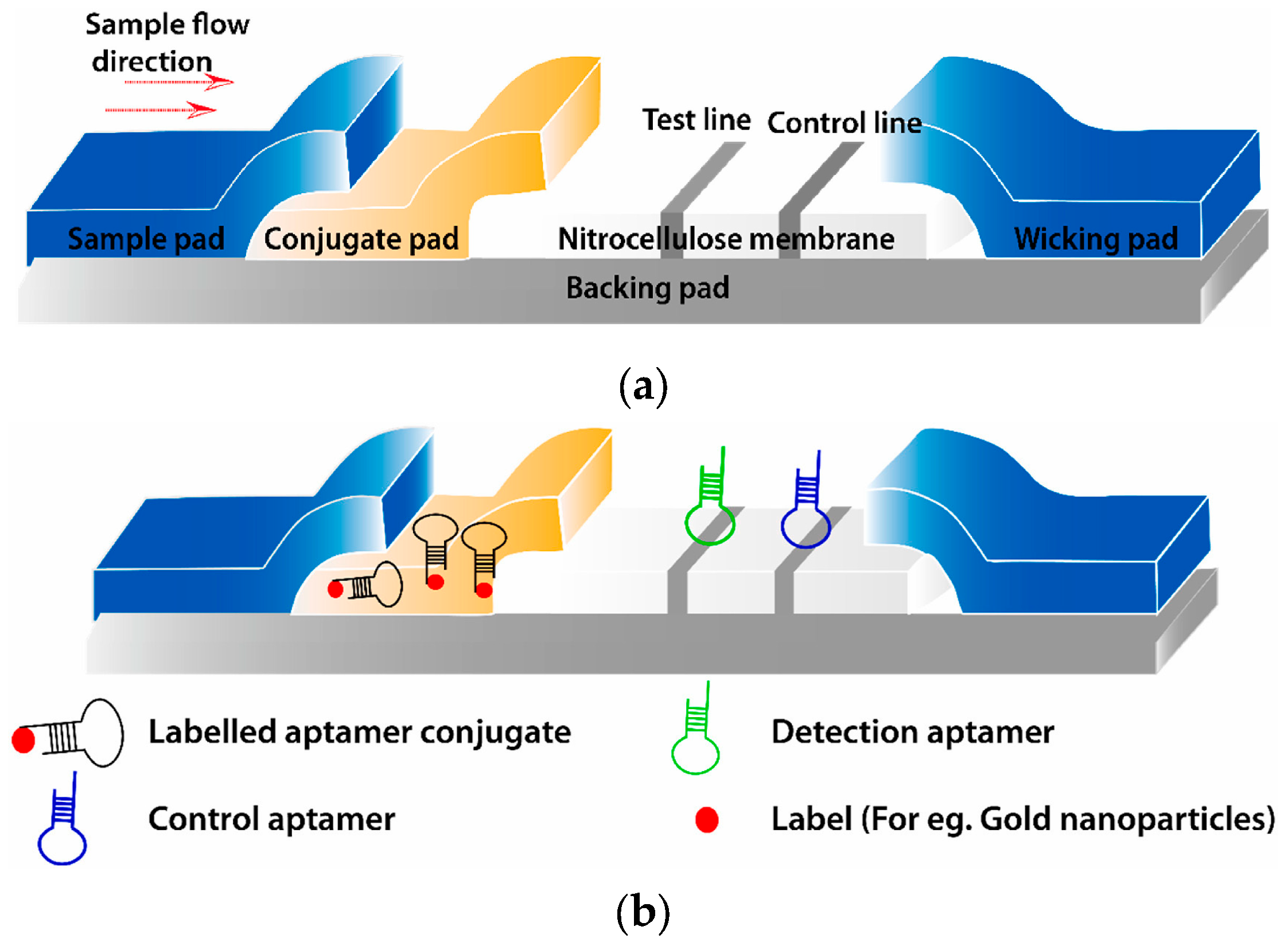
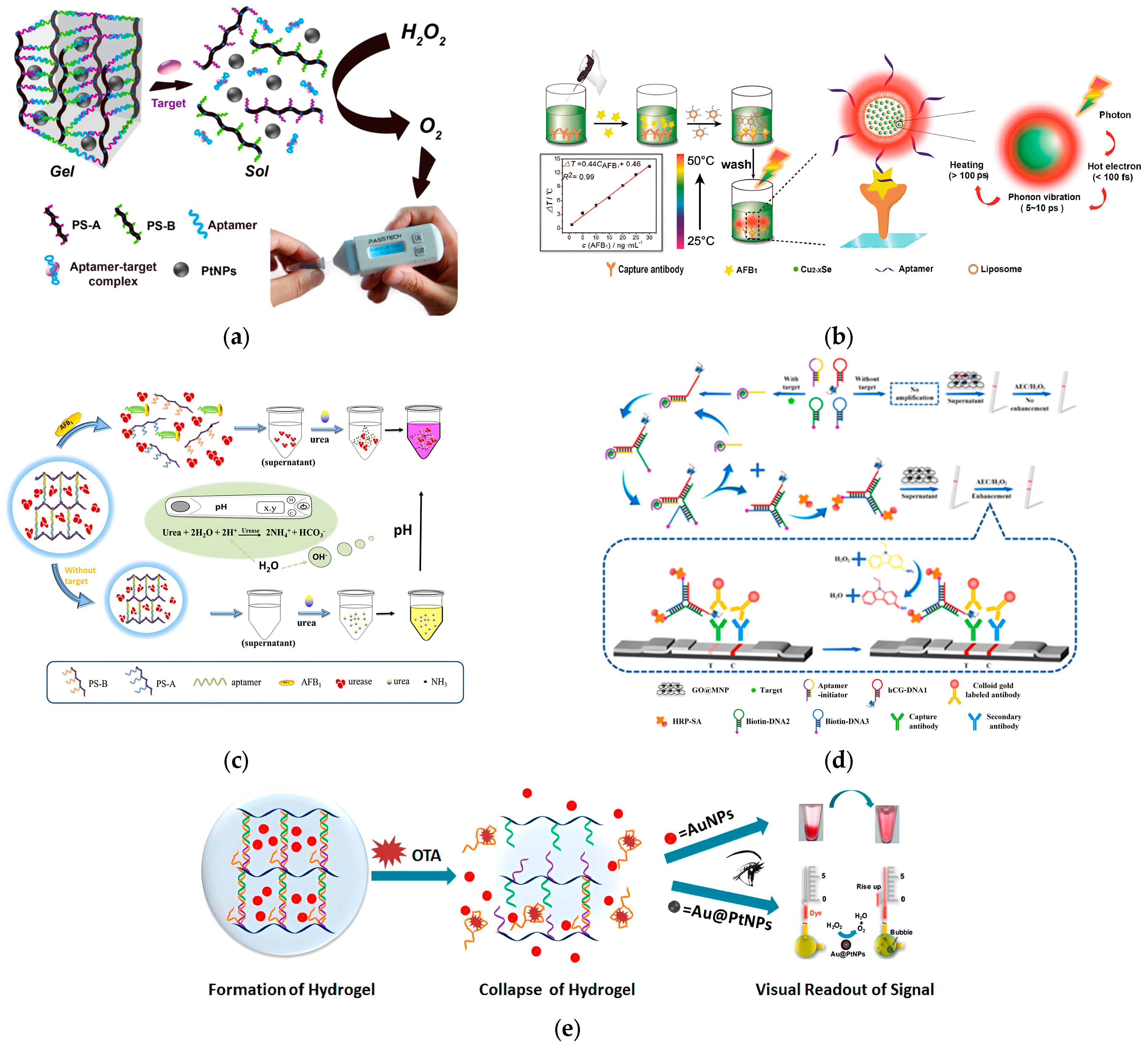
| Features | Aptamer | Antibody |
|---|---|---|
| Ingredient | Oligonucleotides (DNA or RNA) | Proteins |
| Target | Small molecules, proteins, cells, bacteria, viruses and parasites | Proteins and peptides |
| Size | Small (10~20 kDa) | Large (150 kDa) |
| Synthesis method | Chemical synthesis | Biological manufacturing |
| Immunogenicity | Low | High |
| Affinity | High (10 pM to 10 μM) | High (10 pM to 10 μM) |
| Specificity | High | High |
| Stability | High (stable at room temperature) | Low (Refrigerated for storage) |
| Development time | 2~6 weeks | 6~18 months |
| Chemical modifications | Simple and controllable | Restricted and uncontrolled |
| Cost | Low | High |
| Target | Aptamer Sequence (5′–3′) | Secondary Structure | Selection Method | Aptasensor Type | Linear Range μg·kg−1 | LOD μg·kg−1 | Ref. |
|---|---|---|---|---|---|---|---|
| CTX-MI | TTTGGGGATGG GCAACG GTAAAAAGGGTCAAAAGGCTTTT |  | Mag-SELEX | BLI aptasensor | 1.5 × 103~7.5 × 104 | 390 | [40] |
| CT | GGCAAAAAGGATTGCCCAGGTCTGCTGTCTAGCC GGATTC |  | Mag-SELEX | Enzyme-linked aptamer assay | 1~1000 | 2.1 | [41] |
| GTX | AACCTTTGGTCGG GCAAGGTAGGTT |  | GO-SELEX | Label-free and real-time optical BLI aptasensor | 0.2~90 | 0.050 | [52] |
| GYM-A | GCGA CCGAAGTGAGGCTCGATCCAAGG | 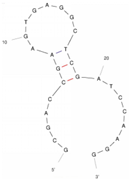 | Capture-SELEX | BLI aptasensor | 28~444 | 3.15 | [53] |
| STX | GGCGGGTTT TGAGGGTC GCATCCCGT GGAAACAGGTTCATTGTTCCCGCC | 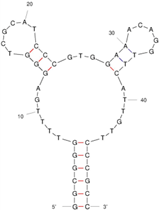 | Mag-SELEX | Label-free colorimetric aptasensor | 0.04356~11.15 | 0.04255 | [42] |
| AFB1 | GTTGGGCA CGTGT TGTCTCTCTGTGTCTCGTGCCCTTCGCTAGGCCCACA |  | Mag-SELEX | Colorimetric aptasensor | 1.56~1599 | 0.587 | [43] |
| Patulin (PAT) | GGCCCGCCAACCCGCATCATCTACACTGATATTTTACCTT |  | GO-SELEX | Colorimetric aptasensor | 0.050~2.50 | 0.048 | [54] |
| Trichothecene mycotoxin (T-2 Toxin) | GTATATCAAGCATCGCGTGTTTACACATGCG AGAGGTGAA |  | GO-SELEX | Fluorescent aptasensor | 233~ 1.75 × 104 | 186 | [55] |
| PTX | GGAGGTGGTGGG GACTTTGCTTGTA CTGGGCGCCCGG TTGAA | 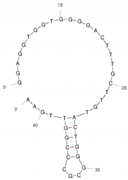 | Mag-SELEX | Real-time optical BLI aptasensor | 0.20~ 0.70 | 0.04 × 10−3 | [44] |
| 20 Methyl Spirolide Gb (SPX G) | CACGACGAGCG ATAGGTTGT GGACATTGACA GGACCGAACA CGCGCCCC |  | Bead SELEX | Microscale thermophoresis aptasensor | 0.0019~ 125 | 0.39 × 10−3 | [56] |
| OA | GGTCACCAAC AACAGGGAGC GCTACGCGAA GGGTCAATGT GACGTCATGC GGATGTGTGG |  | Bead SELEX | Label-free electrochemical aptasensor | 0.1~60 | 0.070 | [57] |
| Microcystin-leucine arginine (MC-LR) | GGCGCCAAA CAGGACCA CCATGACAATTA CCCATACCAC CTCATTATGCC CCATCTCCGC | 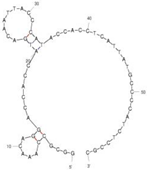 | Bead SELEX | Electrochemical aptasensor | 0.0075~ 0.0127 | 0.010 | [58] |
| ZEN | ATACCAGCTT ATTCAATTCT ACCAGCTTT GAGGCTCGATCC AGCTTATTCAATTATACCAGCTTA TTCAATTATA CCAGCACAATC GTAATCAGTTAG | 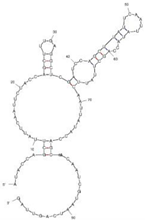 | Capture-SELEX | Lable-free aptasensor | 3.98~128 | 3.98 | [59] |
| Ricin | ACACCCACCGCAGGCAGACGCAACGCCTCGGAGACTAGCC | 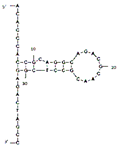 | Bead SELEX | surface enhanced Raman scattering (SERS) aptasensor | 0~50 | 25 | [60] |
| Botulinum toxin | AGGGAAAATTTGACACTTTTCAAAC TGTCCTATGACA GTCCATAGG |  | Mag-SELEX | Electrochemical aptasensor | 15~1500 | 300 | [61] |
| Staphylococcal enterotoxins | AGCAGCACAGAGGTCAGATGTACTTATGCATTTCCTCCCACGATCTTATTTGAGAGTGACCCTATGCGTGCTACCGTGAA | 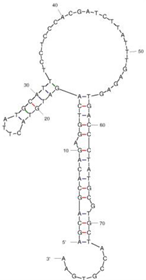 | Mag-SELEX | Fluorescent aptasensor | 0~1.0 × 104 | 8.7 | [62] |
Disclaimer/Publisher’s Note: The statements, opinions and data contained in all publications are solely those of the individual author(s) and contributor(s) and not of MDPI and/or the editor(s). MDPI and/or the editor(s) disclaim responsibility for any injury to people or property resulting from any ideas, methods, instructions or products referred to in the content. |
© 2024 by the authors. Licensee MDPI, Basel, Switzerland. This article is an open access article distributed under the terms and conditions of the Creative Commons Attribution (CC BY) license (https://creativecommons.org/licenses/by/4.0/).
Share and Cite
Li, C.; Zhu, Z.; Yao, J.; Chen, Z.; Huang, Y. Perspectives in Aptasensor-Based Portable Detection for Biotoxins. Molecules 2024, 29, 4891. https://doi.org/10.3390/molecules29204891
Li C, Zhu Z, Yao J, Chen Z, Huang Y. Perspectives in Aptasensor-Based Portable Detection for Biotoxins. Molecules. 2024; 29(20):4891. https://doi.org/10.3390/molecules29204891
Chicago/Turabian StyleLi, Congying, Ziyuan Zhu, Jiahong Yao, Zhe Chen, and Yishun Huang. 2024. "Perspectives in Aptasensor-Based Portable Detection for Biotoxins" Molecules 29, no. 20: 4891. https://doi.org/10.3390/molecules29204891
APA StyleLi, C., Zhu, Z., Yao, J., Chen, Z., & Huang, Y. (2024). Perspectives in Aptasensor-Based Portable Detection for Biotoxins. Molecules, 29(20), 4891. https://doi.org/10.3390/molecules29204891






